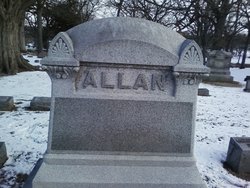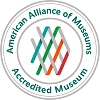William T. Allan – Lane Rebel from the South
Monday, August 12th, 2013by Ron Gorman, Oberlin Heritage Center volunteer docent
I’ve decided for my next two blog entries to tell the stories of two Southern rebels who had a tremendous impact on pre-Civil War Oberlin. But these weren’t Confederate rebels, they were Southern abolitionists, at a time when “abolitionist” was a dirty word even in the North. They were also students of a theological seminary in Cincinnati – a college that tried to stop them from spreading their anti-slavery message and from doing good deeds among the African-American population of that city. But these students wouldn’t be shut down. Instead they left that school in protest. And they came to Oberlin, along with about two dozen of their anti-slavery brothers, in just the second year of the Oberlin colony, and put this town and college on an entirely new course that its founders couldn’t have envisioned just two years earlier. One of these Southern rebels was the son of a respected Southern slaveholder. The other was a native African who himself had been enslaved.
The slaveholder’s son was William T. Allan. He was born in Tennessee in 1810, and moved with his family to Huntsville, Alabama about a decade later. His father, John Allan, was pastor of Huntsville’s First Presbyterian Church. John Allan owned two families of 15 slaves, who William would later say were “almost as kindly treated as slaves can be, yet they pant for liberty”. [1] But even though he owned slaves, John Allan was opposed to slavery. He was not an abolitionist, but a “colonizationist”, believing in the gradual emancipation of the slaves and their colonization back to Africa. He was a co-founder of Alabama’s Society for the Emancipation of Slavery and the Madison County Colonization Society.
For a month in 1832, the Allan family had a houseguest – a young reformer from Connecticut named Theodore Weld. Weld was on a mission from Lewis Tappan, a wealthy New York philanthropist, to travel the country and determine what kind of interest there might be for a new type of college that Lewis and his brother were interested in supporting, called a “manual labor institution”. The idea was that students would engage in manual labor to help pay their way through college, both as a benefit to the college and as moral discipline for themselves. To enhance the moral discipline, the school would teach and emphasize moral values and religious purity. As a secondary goal, Weld was to evaluate existing manual labor institutes that might be worthy of support from the Tappan brothers.
Theodore Dwight Weld
Weld did find such an institute, the Lane Seminary in Cincinnati, and he spoke about it to interested young men who he met in his travels, like William T. Allan (who would become a lifelong friend) and his brother James. Weld, the Allans, and several more of these young men enrolled in the Lane Seminary and arrived there in 1833 to begin their studies.
During the course of his nationwide tour, Weld became zealously committed to the abolitionist cause – believing that slavery was a sin and should be abolished immediately, without colonization. [2] Once his original mission was complete, he embarked on a new, personal mission to abolitionize the students of the Lane Seminary. His first target was William Allan. William was a colonizationist, like his father and like most of the Lane recruits. But it didn’t take much effort for Weld to convert him into a full-fledged abolitionist.
With that, Allan became an ally of Weld, spreading the abolition message through the Lane student body. Soon they had enough converts that they felt comfortable challenging the colonizationists to a series of debates. The debates would cover 18 evenings, at two and a half hours each. Seventeen students eagerly participated in the debates, many of them recruits who Weld had met during his travels, and most of whom had first-hand experience with slavery in the South, like James A. Thome, the son of a wealthy Kentucky slaveholder, and Huntington Lyman, a Connecticut native who had spent several years in Louisiana.
The debates were held in February, 1834. Weld, a very powerful and persuasive orator, was the keynote speaker. He spoke for two nights, followed by two nights of group discussion and debate. This was followed by four nights of first-hand testimony about slavery. This was probably the most powerful part of the debates, and William Allan led it off. Here’s part of what he had to say:
What is slavery? Before we can prescribe a remedy, we must understand the disease. We must know what we are attempting to cure, before we give the medicine…
At our house it is so common to hear their screams from a neighbouring plantation, that we think nothing of it. The overseer of this plantation told me one day, he laid a young woman over a log, and beat her so severely that she was soon after delivered of a dead child. A bricklayer, a neighbor of ours, owned a very smart young negro man, who ran away, but was caught. When his master got him home, he stripped him naked, tied him up by his hands, in plain sight and hearing of the academy and the public green, so high that his feet could not touch the ground ; then tied them together, and put a long board between his legs, to keep him steady. After preparing him in this way, he took a paddle, bored it full of holes, and commenced beating him with it. He continued it leisurely all day. At night his flesh was literally pounded to a jelly. It was two weeks before he was able to walk. No one took any notice of it; no one thought any wrong was done…
And lest any one should think that in general the slaves are well treated, and these are the exceptions, let me be distinctly understood — Cruelty is the rule, and kindness the exception.[3]
One audience member remarked later, “I was rejoiced to hear such a beginning from the son of a slave-holder; for I had longed to learn the true condition of the slave.” Several other students also gave first-hand accounts of slavery, including James Thome and Huntington Lyman. The abolitionism portion of the debates ended on the ninth evening with a vote being taken on the following question: “Ought the people of the slaveholding states to abolish slavery immediately?” The answer was a unanimous Yes (although a few students who hadn’t made up their minds abstained from voting).
The students then entered into nine evenings of debate about the colonization issue, which included readings from extensive reports, addresses and repositories of the American Colonization Society. According to student Henry B. Stanton, just reading the colonization society’s own promotional material was enough to change many attitudes:
Most of the Colonizationists who expressed any opinion on the subject, declared their ignorance of the doctrines and measures of the Society until this debate. They cannot find words to express their astonishment that they should have been so duped into the support of this Society, as a scheme of benevolence towards the free blacks, and a remedy for slavery. They now repudiate it with all their hearts.[4]
And thus when a vote was taken on the final night of the debates concerning the colonization issue, only one student voted in favor of colonization, with all the others opposed (except a handful of abstainers, as before). The debates inspired the students to start their own anti-slavery society, with William Allan as President. Many of the students also started distributing abolitionist literature and going out into the Cincinnati African American community to teach and minister to the large population of ex-slaves there. Said Henry Stanton, “Almost all of our southern brethren are engaged in colored Sabbath schools and Bible classes. Some of them have devoted their lives in doing good to that oppressed race.”
But racism, which was prevalent in Ohio at that time (especially in Cincinnati, situated right across the Ohio River from the slave state of Kentucky), reared its ugly head. The students met with much abuse and condemnation from white residents, and the Lane Seminary itself came under fire from the local community and its supporters, many of whom were slaveholders or conducted business with slaveholders. The school was even threatened with mob violence. The trustees of Lane Seminary asked the students to desist from their activities, but a committee of students, chaired by William Allan, stood firm. Finally the trustees came down hard on the students, banning any further anti-slavery discussion or activities, firing a professor, and recommending expulsion procedures against Weld and William Allan. As a result, several dozen students quit the school in protest, becoming known as the “Lane Rebels”.
When news reached Huntsville, Alabama that the Allan boys had left Lane, their father was not happy, and their neighbors were incensed when they learned of their abolitionist activities. Said William, “They blow away against abolitionists down there at a terrible rate – say they’ll cut my throat, that I’m afraid to come home, etc.”[5] However, one of Allan’s Huntsville neighbors, James Birney, a wealthy slaveholder who had co-founded the local emancipation and colonization societies with John Allan, was so moved by the Lane debates that he emancipated all of his slaves and became an outspoken abolitionist.
The news of what happened at Lane also sent shockwaves through colleges throughout the North. Many institutions suddenly became aware of student anti-slavery societies on their own campuses and shut them down, in hopes of staving off a similar disaster. One college, however, had the opposite reaction. John J. Shipherd, a member of the Western Reserve Anti-Slavery Society and the co-founder of a newly formed manual labor institution called the Oberlin Collegiate Institute (now Oberlin College), went down to Cincinnati to visit the Lane Rebels and invite them to Oberlin, promising that their philanthropic and anti-slavery activities wouldn’t be squelched there. After a complex set of negotiations (which I’ll describe in more detail in my next blog post), about two dozen of the Rebels agreed to come to Oberlin and enroll in the newly formed Theological Department, headed by the renowned revivalist minister, Charles G. Finney, with generous financial support from the Tappan brothers. William Allan said of the plan, “This Oberlin plan, however, has opened up a new train… That, with me, will be putting on the capstone–I shall have passed the rubicon if I should go to an institution where abolition is concentrated–at the head of which is that arch-heretic Finney.”[6] James Thome and Huntington Lyman joined Allan in heading to Oberlin. Theodore Weld enthusiastically supported the move, but did not join in himself. Flushed with his success at abolitionizing first William Allan and then the Lane Seminary, he instead took off on a remarkable speaking campaign across the state that would “fast abolitionize Ohio” and create dozens of new local anti-slavery societies.
When the Lane Rebels came to Oberlin in early 1835, abolitionist students who had been silenced by other colleges in the North followed suit. Thus the fledgling colony of Oberlin became a major national center of abolitionism virtually overnight. This was encouraged by Weld, who arrived in Oberlin in late 1835 and gave rousing anti-slavery lectures for 21 nights. According to student James Fairchild (future Professor and College President), Weld spoke with such “fervid eloquence” that “Oberlin was abolitionized in every thought and feeling and purpose.” The college leadership remained true to their word of allowing unrestricted free speech, although Reverend Finney did attempt to temper the enthusiasm, believing the students should devote their time to general moral reform and revivalism, which he felt would ultimately lead not only to the abolition of slavery, but of all earthly sin. In 1836 Allan wrote to Weld, “Bro. Finney has used his heart & head & influence to convince us that it is our duty to preach. He groans over the subject & speaks of himself as being agonized about it. Thus we are situated–you and Stanton groaning on one side & Finney on the other.”[7]
But it was the groans of Weld and Stanton that persuaded Allan. He and fellow rebels James Thome, Huntington Lyman, John Alvord, and Sereno Streeter became lecturing “agents” of the American Anti-Slavery Society, numbering among “The Seventy” apostles of aboltionism who were selected to be trained by Weld to travel all over the North, endure peltings with rotten eggs, stones and bricks, and convert thousands to the cause. (Allan and Thome had already become members of the Ohio Anti-Slavery Society at its charter meeting in Zanesville in April, 1835.)
William Allan graduated from Oberlin college in 1836 and began a long and active anti-slavery career. He preached and lectured against slavery in Ohio, New York, Michigan, Indiana, and Illinois, finally settling in the latter and becoming an agent of the Illinois Anti-Slavery Society. In 1839 Theodore Weld published a testimonial from William Allan in his book about the horrors of slavery. In the 1840s Allan became an organizer of the Illinois and Iowa chapters of the first national anti-slavery political party, the Liberty Party, which nominated his ex-Huntsville neighbor, James Birney, for President of the United States. When William’s mother became mortally ill in 1841, his father advised him not to return home, as local sentiment was so strong against him that he feared for his safety. John Allan himself died in 1843, freeing his slaves in his will. William remained in Illinois and helped free slaves himself, his home becoming a sanctuary on the Underground Railroad. He died in Illinois in 1882 after a long, distinguished and honorable public career.
Allan family tomb in Illinois. (Unfortunately this is the closest we have to a picture of William T. Allan)
(By the way, if you’re wondering why I haven’t made any mention since the first paragraph of the ex-slave rebel who came to Oberlin, it’s because I’ll be telling his story in detail in my next blog post. Stay tuned!)
Sources consulted:
Benjamin P. Thomas, Theodore Weld: Crusader for Freedom
Elizur Wright, The Quarterly Anti-slavery Magazine, Volume 1
Henry B. Stanton, “Great Debate at Lane Seminary”, letter to Joshua Leavitt, March 10, 1834
“William T. Allan and Lane Seminary”, The Wilbur H. Siebert Underground Railroad Collection
Robert Samuel Fletcher, A history of Oberlin College: from its foundation through the Civil War, Volume 1
Theodore Dwight Weld, Letters of Theodore Dwight Weld, Angelina Grimké Weld and Sarah Grimké, 1822-1844, Volume 1
“Rev William T Allan”, Find a Grave
James Harris Fairchild, Oberlin: the colony and the college, 1833-1883
Theodore Dwight Weld, American Slavery as it is
Reinhard O. Johnson, The Liberty Party, 1840-1848
William Birney, James G. Birney and his times
“James Gillespie Birney”, Huntsville History Collection
John Allan Wyeth, With Sabre and Scalpel. The Autobiography of a Soldier and Surgeon
“Rev. John Allan”, Huntsville History Collection
“General catalogue of Oberlin college, 1833 [-] 1908”, Oberlin College Archives
Ann Hagedorn, Beyond the River
FOOTNOTES:
[1] Birney, p. 106; Weld, American Slavery, p. 47
[2] Thomas, Chapter 2
[3] Wright, p. 64
[4] Stanton, March 10, 1834
[5] Thomas, Chapter 6
[6] Weld, Letters, p. 190








